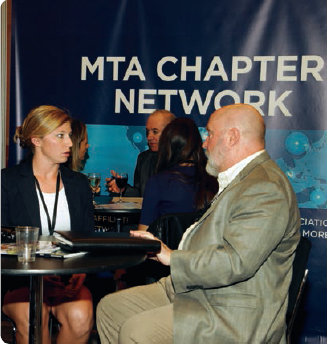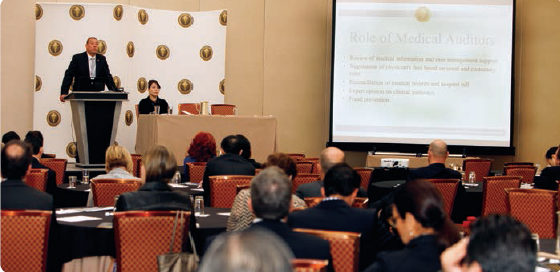The University of Texas M.D. Anderson Cancer Center in Houston, Texas, is one of the world’s most respected institutions devoted exclusively to cancer patient care, research, education and prevention. As an internationally recognized cancer center, tending to the needs of such a diverse referral base has implications far outside the local market, extending into regional and national as well as international locales.
M.D. Anderson’s Office of Physician Relations is responsible for improving the referring physician experience. Our vision is to position M.D. Anderson as the oncology referral center of choice, and to be a recognized world leader in the creation of a collaborative physician community aimed at Making Cancer History®.
Exhibiting Strategy
In the local Houston market, we employ a team of physician relations specialists who are responsible for in-person, in-office relationship building with our referring physicians for the purpose of providing education and information that supports optimal referral decision making for their patients. Given that approximately 70 percent of M.D. Anderson’s patients come to us from outside the local area, it is imperative that we have an effective process for building those personal relationships with physicians in more distant communities.
We have discovered that exhibiting at medical society conferences and meetings provides the institution with a national and international footprint for physician and referral relations activities. These meetings offer a unique way to establish personal relationships with physicians and other health professionals in attendance.
The value of branding MDACC cannot be underestimated. MDACC has a very strong brand visibility, our brand is more than just a logo, our brand underpins all aspects of our business. How we think. How we act. And how we look. Brand
Approximately 70 percent of M.D. Anderson’s patients come to us from outside the local area.
positioning describes how we want the world to think about us. It defines the position we want to hold in the minds of our audience. Our positioning is we are the global leader in fighting cancer. A brand promise is the statement we make to our audience about what it should expect in its interactions with us – how we will serve and what we will deliver.
We will create the best possible environment to help you fight cancer. The brand personality describes the human qualities that connect our brand to our audience. Our brand personality is: Focused, Pioneering, Driven, Compassionate, Trusted Experts.
While medical society meetings may be considered an expense on the balance sheet, we believe the process and strategy is clearly an investment that supports MD Anderson’s physician relationships, which many of our colleagues regard as a strategic asset of the organization, and is supportive of our overall brand presence.
Criteria for Identifying and Selecting a Medical Society Meeting
Selecting the right medical society meeting should be guided by organizational and physician relations goals and objectives. A key component of the Office of Physician Relations-led “Physician Growth and Reputation” planning process is the exhibiting strategy.
For example, if the goal is to educate attending physicians about the organization’s clinical trials, it is critical to ensure that the meeting selected is attended by physicians who are interested in clinical research, and whose patients may benefit from their physicians receiving additional information and education about those trials to support optimal referral decision making, and ultimately improved care for those patients.
An additional consideration is to place more emphasis on meetings attended by primary care physicians, who are more likely to initially diagnose a cancer patient. Often, it is the newly diagnosed and previously untreated patients who are more likely to be eligible for particular clinical trials. Priority criteria include:
- Physician specialty focus
- Location (local, national, international)
- Attendance
- MD Anderson faculty speaker presence
- Conference alignment with clinical growth and reputation planning
- Clinical trial recruitment priorities
Exhibit Design

M.D. Anderson exhibits need to have an inviting, comfortable space staffed by the knowledgeable people in order to facilitate a dialogue about physician needs and reasons for attending the conference. This gives us the opportunity to think about a solutions-based strategy that focuses on the physician’s needs.
Invest in a quality and creative display that will attract attention and get people talking about the organization. Identify a good exhibit company that will work with you to understand your needs in order to ensure that the exhibit presence is memorable and unique, enabling you to make a lasting impression with the physician audience.
When it’s time to design the exhibit here are the important points we consider at MD Anderson:
- Who we are: We want visitors to be able to find M.D. Anderson easily at the Medical Society Conferences. We have put our M.D. Anderson logo with black letters on white background with the word “Cancer” is crossed out and our brand “Making Cancer History” with white letters on red background at the maximum height and we repeated it in several different locations like table throw and additional pop up banner throughout the design.
- What you do: We also have a display banner that explains in six bullets how MDACC makes cancer history so that the visitor can relate who we are to what we do. Once they understand who we are and what we are, it’s time to explain why this is important and how it will add to their interest whether referring a patient, collaborating with us or seeking education at M.D. Anderson Cancer Center.
- Pictures: We sometimes use patient photos for display. Photos need to be high resolution otherwise it will take away the interest. We usually prefer to put pediatric patient pictures with their physician. As a health institution, we always need to get patient consent for those photos.
- Text: We put less text. People do not have time to stand and read all the text. It has to be short and needs to grab attention quickly.
- Lighting: Lighting is very important; we use halogen spotlights on our display. This will set the tone and provide a more open and energetic mood at the exhibit booth.
Technology & Social Media: We add a monitor to show MDACC loop video or show physician relation twitter feeds in large medical society meetings. This gives us an easy way to gain more attention and attracts more people. We also tweet before, during and after the meetings. We tweet pictures and share on Facebook.
The Exhibiting Process: Before, During, and after the Meeting
Before the Meeting – Exhibit Design, Staffing and Communications:
Once we have determined which meeting to attend, a communications plan must be implemented to reach the intended audience and inform them of our presence at the meeting. For example, a pre-conference invitation to visit our exhibit may be mailed out to potential attendees and complemented by social media, such as Twitter and Facebook posts, along with information on our dedicated physician microsite, physicianrelations.org.
Pre-event email has a role to play also, but there are some inherent challenges. Most attendees receive a variety of emails inviting them to “come visit us at booth # X.” Our experience has been that moving to the social media platforms and use of the institution’s website has proven most beneficial for informing attendees and potential attendees about our exhibiting presence at these meetings.
Our experience from past meetings and feedback received from physician attendees tells us that the following content is of most interest to conference attendees:
- Medical education materials
- Physician and scientist training opportunities
- Clinical trials
- Instructions about how to refer a patient
- Registration on the myMDAnderson physician portal
-
During the Meeting – Engagement:
In determing the best people from your organization to staff the exhibit booth, it is typical to have people from your physician relations department, who are adept at engaging and building relationships with physician attendees. Staffers should be people-oriented and most knowledgeable about our institution.
These staff should be well-versed in attracting; utilizing probing questions to fully understand the needs and expectations of the physician attendees, and who can successfully deliver on those expectations.
Number of staff should be calibrated based on the size of the exhibit real estate, hours the exhibit hall is open to attendees, and expected traffic to the exhibit booth. It has also proven valuable to have members of the clinical faculty and/ or their staffs spend time in the exhibit booth to meet their colleagues.
As attendees approach the exhibit booth, it is important to be approachable and creative, as the initial aim is to start a dialogue. The personal connection builds trust. Meeting face-to-face, a prospective physician is much more likely to be comfortable being approached and learning about what our organization has to offer to his or her practice.
Once the physician is engaged, the conversation can move quickly into a virtual “office visit” that may represent a condensed version of what the physician relations staff member experiences during a regular routine of conducting in-person office visits in the local market.
After the Meeting – Lead Management, Follow-up and Measures of Success:
Lead generation is the most frequently cited measure of medical society meetings effectiveness. Yet overall success depends on effective follow-up that sustains and enhances the physician relationship that may eventually lead to registration on the physician portal, and ultimately to the referral of appropriate patients to support the patient care and clinical research mission of the cancer center.
A Qualified Lead is defined as:
- Physician Relations staff was personally and directly engaged with the physician attendee
- During this engagement, several key questions were discussed, such as whether the physician has referred patients, are they interested in clinical trial information, and/or are they interested in information about educational courses or medical conference information
- The physician responses are well-documented, and their contact information has been captured either by scanning a badge or completing a physician relations information sheet

- A next step has been identified and agreed upon by the visitor. Information requested can either be directmailed or emailed following the conference
We need to get the leads to the people who will followup on them quickly. Time is of the essence. The value of a lead diminishes by 15 percent per week. The most important thing to remember is that exhibiting return on investment is usually hidden in your leads and typically requires a long leadtime to realize the return on the exhibiting investment. Thus, it is important to follow up with physician attendees and to monitor those that refer a patient either via phone or through the physician portal.
It is also critical to continue branding after the event through our social media avenues in order to stay top-of-mind not only for existing physician relationships, but also for creating and enhancing brand awareness for those who may not have had the opportunity to attend the meeting.
A variety of additional metrics can be used to complement the determination of a successful exhibit activities process. The following metrics are used routinely to monitor effectiveness and provide a focus around both activity and outcome indicators:
- Number of physicians who register on the physician portal
- New patient referrals
- Number of physicians making referrals following the exhibit experience
- Number of patients referred by physician attendees.
- Enhancing physician reputation (may be measured by dedicated survey processes)
Resource Requirements

Costs vary significantly by conference, duration of the conference, location, and by the type, size, and amenities of the exhibit-booth display. Exhibiting expenditures are the second largest item in the business, marketing and communications budget after advertising for many organizations. This expense accounts for nearly one-fifth of the total budget for U.S. firms and approximately one-fourth of the budget for European firms (Jacobson 1990, Schafer 1987).
Typical costs that need to be considered include:
- Pre- and post-show communications
- Travel, lodging and meals
- Freight and drayage
- Show labor, carpeting and electricity
- Special lighting
- Internet access
- Display monitors and technical support
- Exhibit booth artwork
- Furniture
Conclusion
Having a conference exhibition at various medical society meetings adds value for the organization when done correctly. We believe that exhibiting is a wise, strategic, cost-effective and an operationally efficient investment for the physician relations programs in many healthcare organizations. Even if not seen immediately, the long-term benefits of the physician relationship building effort are well-documented.
Exhibiting at medical conferences and meetings makes more sense than ever in this changing healthcare environment. Whether one is seeking to develop new physician relationships, reinforce existing relationships or demonstrate new services and programs in a controlled presentation environment, we see that more hospitals are exploring opportunities to become involved in the exhibiting activities process.
About the Author

Elnar Koseoglu is the program manager of International Referral Development in the Office of Physician Relations at M.D. Anderson Cancer Center. In addition to direct physician support, Elnar also assists international hospitals and organizations with conference development, joint physician education opportunities and other physician-oriented partnerships. Elnar is a native of Turkey, holds a Bachelor of Science in Economics and a Master of Arts in European Relations. She has 15 years of experience working with international patients and physicians. Elnar has worked with multiple International communities in the Houston area, providing support for cancer patients and their families. Elnar may be reached at 713-563-5849 and by email ekoseogl@mdanderson.org












